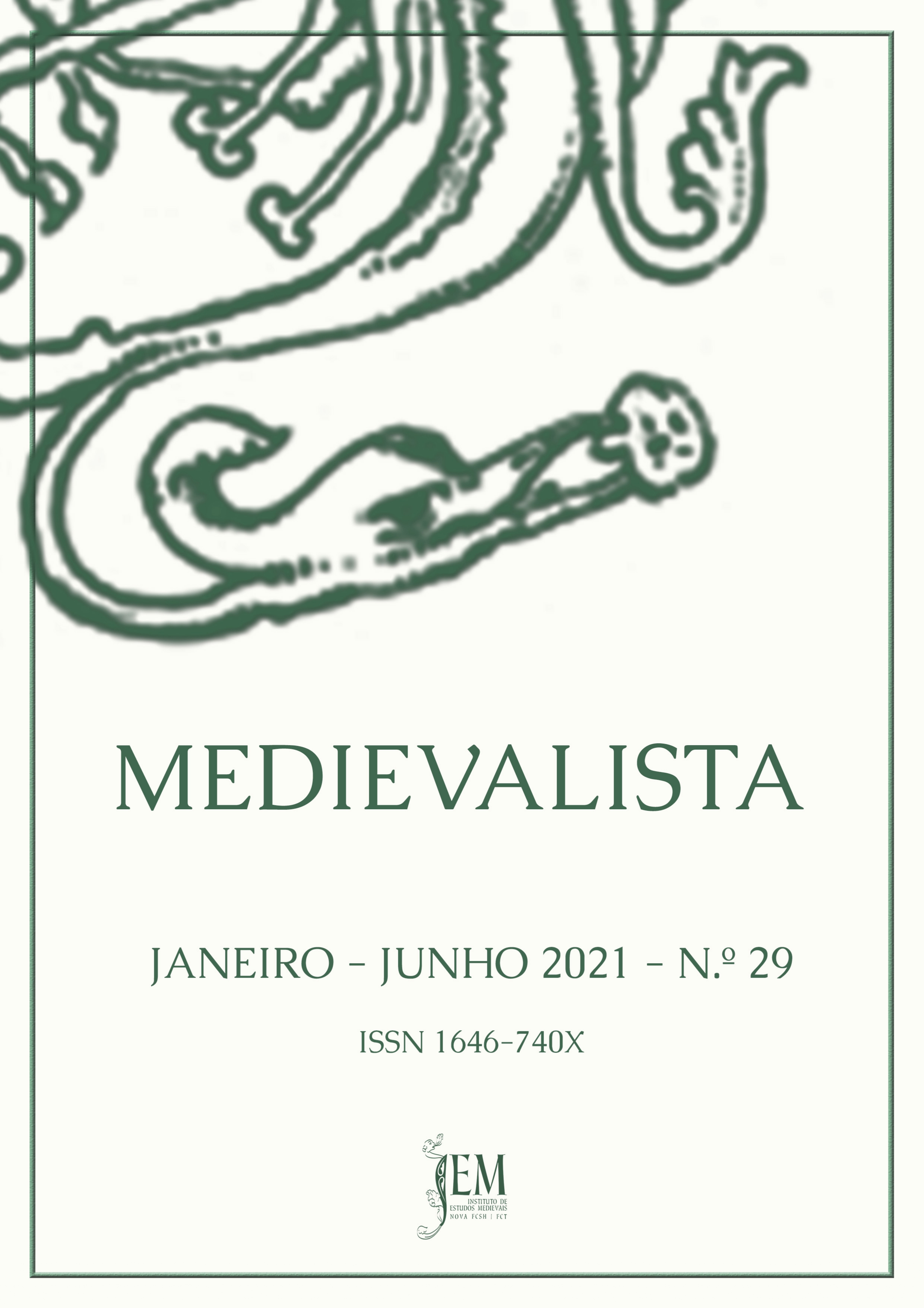Evidences of Patronage in Medieval Bestiaries
DOI:
https://doi.org/10.4000/medievalista.3877Keywords:
Patronage, Aberdeen Bestiary, Ashmole Ms. 1511Abstract
The present article is part of an ongoing Master’s degree research in Universidade de Brasília (UnB), and proposes to indicate visual evidence of patronage in two British medieval bestiaries of the second family, Bodley Ashmole Ms. 1511 and Aberdeen Bestiary Ms. 24. The proposal of patronage is based on the theory that both are luxury bestiaries and which were possibly made by at least one illuminator in common, and are also the copies of an unknown manuscript. It is tried to affirm this theory from material and visual analysis of the manuscripts, where it is focused on the illumination of the bird Pica, called Pêga in Portuguese. Based on the theories of the relationship between text-image and hierarchy of images, addressed by several authors, the study here draws a comparative parallel between the two bestiaries mentioned above with six other manuscripts and identifies that there is a difference besides the stylistic in the illuminations. It is considered that this imaginary discrepancy may be related to the patronage of the manuscripts, or the manuscript which model served as the basis, thus providing us with a different and in-depth look at the production of luxury manuscripts and luxury bestiaries, and their relationship with society, such as literary consumption.
Bibliography
Handwritten sources
Aberdeen, Aberdeen University Library, Ms. 24. Disponível em http://www.abdn.ac.uk/bestiary/.
Canterbury, Canterbury Cathedral Library, Ms. Lit. D 10. Disponível em: https://ims.canterbury-cathedral.org/advsearch.tlx?advsearchid=1537809368>.
Copenhague, Kongelige Bibliotek, Ms. Gl, kgl, S. 1633 4º. Disponível em http://www.kb.dk/permalink/2006/manus/221/eng/50+recto/?var=.
Los Angeles, Getty Museum, Northumberland Bestiary Ms. 100. Disponível em http://www.getty.edu/art/collection/objects/240115/unknown-maker-northumberland-bestiary-english-about-1250-1260/?dz=0.5000,0.5000,0.67.
Nova Iorque, Morgan Library Ms. 81. Disponível em http://ica.themorgan.org/manuscript/thumbs/77019.
Oxford, Bodleian Library, Ms. Ashmole 1511. Disponível em https://digital.bodleian.ox.ac.uk/inquire/p/fb43631c-1f61-4865-806c-9fe59b5753ff.
Paris, BnF, Ms. lat. 6838b. Disponível em http://mandragore.bnf.fr/ark:/12148/cgfbt65935s.
Paris, BnF, Ms. lat. 3630. Disponível em https://gallica.bnf.fr/ark:/12148/btv1b100329427/f90.image.r=3630%20bestiaire.
Studies
BAXTER, Ron – Bestiaries and Their Users in the Middle Ages. Phoenix Mill: Sutton, 1998.
BAXTER, Ronald – “A baronial bestiary: heraldic evidence for the patronage of MS. Bodley 764”. Journal of the Warburg and Courtauld Institutes 50 (1987), pp. 196-200.
BENTON, Janetta Rebold – Materials, Methods, and Masterpieces of Medieval Art. Santa Barbara: ABC-CLIO, 2009.
CLARK, Willene B. – A Medieval Book of Beasts: The Second-Family Bestiary: Commentary, Art, Text and Translation. Woodbridge: Boydell Press, 2006.
CLARKE, Mark – “Anglo-Saxon manuscript pigments”. Studies in Conservation 49/4 (2004), pp. 231-244.
COWELL, Andrew – The Medieval Warrior Aristocracy: Gifts, Violence, Performance, and the Sacred. New York: Boydell & Brewer, 2007.
DAVIS, Henry William Carless; JOHNSON, Charles – Regesta regum anglo-normannorum, 1066-1154. Oxford: Clarendon Press, 1913.
DAVY, Marie-Madalene – Initiation à la Symbolique Romane. Paris: Flammarion, 1977.
DUBY, Georges – The early growth of the European economy: Warriors and peasants from the seventh to the twelfth century. New York: Cornell University Press, 1978.
DUBY, Georges – História Artística da Europa: A Idade Média, São Paulo: Editora Paz e Terra, 1997.
FOUILLOY, Hugh of; CLARK, Willene B. – The medieval book of birds: Hugh of Fouilloy’s Aviarium. Edition, translation and commentary by Willene B. Clark. Binghamton (N.Y.): Medieval and Renaissance texts and studies, 1992.
GÁL, Erika – «“Fine Feathers Make Fine Birds”: The Exploitation Of Wild Birds In Medieval Hungary». ANTÆUS 33 (2015), pp. 345-369, 2015.
GEDDES, Jane – “Observations on the Aberdeen Bestiary”. Reinardus. Yearbook of the International Reynard Society 11 (1998), pp. 67-84.
JAMES, Montague R. – The Bestiary. Oxford: Roxburghe Club, 1928.
JESSOP, Oliver – “A new artefact typology for the study of medieval arrowheads”. Medieval Archaeology 40/1 (1996), pp. 192-205.
JOHNS, Susan M. – Noblewomen, aristocracy and power in the twelfth-century Anglo-Norman realm. Manchester; New York: Manchester University Press, 2003.
KAY, Sarah – «'The English bestiary', the continental' Physiologus', and the intersections between them». Medium Aevum 85/1 (2016), pp. 118-142.
KUMLER, Aden – “The Patron-Function”. in HOURIHANE, Colum (ed.) – Patronage: Power and Agency in Medieval Art. University Park: Penn State University Press, 2013, pp. 297-319.
MCCULLOCH, Florence – Mediaeval Latin and French Bestiaries. Chapel Hill: University of North Carolina Press, 1962.
MCGRADY, Deborah – The Writer’s Gift or the Patron’s Pleasure? The Literary Economy in Late Medieval France. Buffalo: University of Toronto Press, 2019.
MERMIER, Guy R. – “The Phoenix: Its Nature and Its Place in the Tradition of the Physiologus”. in CLARK, Willene B.; McMUNN, Meradith T. (eds.) – Beasts and Birds of the Middle Ages: The Bestiary and Its Legacy. Philadelphia: University of Pennsylvania Press, 1989, pp. 69-85.
MURATOVA, Xenia – “Workshop Methods in English Late Twelfth-Century Illumination and the Production of Luxury Bestiaries”. in CLARK, Willene B.; McMUNN, Meradith T. (eds.) – Beasts and Birds of the Middle Ages: The Bestiary and Its Legacy. Philadelphia: University of Pennsylvania Press, 1989, pp. 53-68.
PASTOUREAU, Michel – Bestiaires du Moyen Âge. Paris: Seuil, 2011.
SCHMITT, Jean-Claude – O Corpo das Imagens: Ensaio Sobre a Cultura Visual na Idade Média. Bauru: EDUSC, 2007.
SERJEANTSON, Dale – “A dainty dish: consumption of small birds in Late Medieval England”. in BUITENHUIS, H. and PRUMMEL, W. (eds.) – Animals and Man in the Past. Essays in Honour of Dr. A.T. Clason, Emeritus Professor of Archaeozoology Rijksuniversiteit Groningen, the Netherlands. (ARC-Publicaties: Archaeological Research and Consultancy Publication, 41) Groningen, Holland: ARC-Publicaties, 2001, pp. 263-274.
STACYE, J. – “Priory and Parish Church of Worksop or Radford, Nottinghamshire”. Journal of the British Archaeological Association: First Series 30/2 (1874), pp. 156-170.
SWAINSON, Charles – Provincial Names and Folk Lore of British birds. Londres: English Dialect Society, Trübner and Co., 1885.
TEODORESCU, Bianca M.; CALIN, Răzvan-Alexandru; BUSU, Oprea-Valentin. – “Communication Gift Code”. New Approaches in Social and Humanistic Sciences 1/1(2016), pp. 503-506.
THOMAS, Hugh M. – The Secular Clergy in England, 1066-1216. Oxford: Oxford University Press, 2014.
VEGVAR, Carol Neuman de – “Birds of a Feather: Magpies in the Bayeux Tapestry?”. in FREDERICK, Jill; HYER, Maren Clegg (eds.) – Textiles, Text, Intertext: Essays in Honour of Gale R. Suffolk: Owen-Crocker. Boydell and Brewer, 2016, pp. 85-102.
Downloads
Downloads
Published
How to Cite
Issue
Section
License
Copyright (c) 2024 Medievalista

This work is licensed under a Creative Commons Attribution 4.0 International License.





















